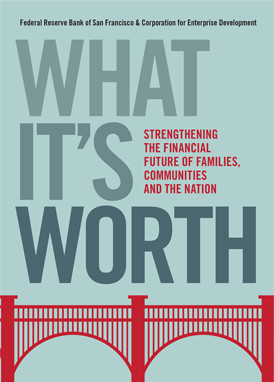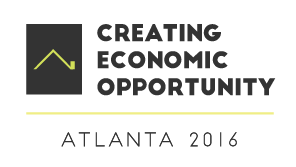This year, NeighborWorks America is focusing on “creating economic opportunities” in all four of the Wednesday symposia at its training institutes. To whet your appetite, I excerpt from the new book “What It’s Worth” a few of the authors’ solutions to various aspects of the financial crisis among America’s communities and families. Read the first part here.
'Facilitation' is key to behavior change
"How the Road to Financial Security is Paved with Financial Capability": Andrea Levere and Leigh Tivol, Prosperity Now
 It’s often insufficient to educate families and individuals about personal finance through classes, workbooks or even traditional counseling. The ultimate goal is behavior change—action—and that requires coaching to build “financial capability,” along with some built-in “facilitators.” NeighborWorks America adopted financial capability coaching as a core competency early on, and these two authors from Prosperity Now reinforce why that was a smart decision.
It’s often insufficient to educate families and individuals about personal finance through classes, workbooks or even traditional counseling. The ultimate goal is behavior change—action—and that requires coaching to build “financial capability,” along with some built-in “facilitators.” NeighborWorks America adopted financial capability coaching as a core competency early on, and these two authors from Prosperity Now reinforce why that was a smart decision.
“In our demonstration project for IDAs (individual development accounts), we found that incentives, such as savings matches, matter — but not as much as we thought,” they write. “Built-in, institutional arrangements, from direct deposits to peer counseling, mattered as much or more in helping savers reach their goals—whether it be going back to school, buying a home or a starting a new business.”
The authors call out a few words or phrases that describe the practices most important to increasing the reach and efficacy of financial capability programs:
-
Integration: Rather than considering it a separate service or program, growing numbers of government agencies, nonprofits and businesses are embedding financial capability into their employee relations and interactions with clients.
-
Credit scores: Not only must credit scoring be made more transparent, say the authors, but “big data” should be leveraged to develop alternative methods of creating meaningful scores so that the tens of millions of “credit invisibles” can be brought into the system and reap the benefits. For example, NeighborWorks America is supporting research into how to factor in a history of paying rent on time.
-
Product innovation: The authors point to FDIC Model Safe Accounts, which bring underserved consumers into the financial mainstream with safeguards such as elimination of overdrafts, as among the most promising product innovations in today’s marketplace. Another is the expansion of employer-based assistance such as opt-out retirement-savings programs (versus those that require workers to initiating by opting in). A previous blog post that reviewed the book “Scarcity” explains in more detail how these sort of behavioral “facilitators” work, and why.
Early start critical to educational status
"A Lifecycle Approach to Putting Higher Education within Reach": Martha Kanter, New York University
It might surprise you to learn that the United States is not even among the top 10 nations in terms of college graduates. Our young adults perform at abysmally lower rates in literacy, numeracy and problem solving than their peers in 21 other countries. The depressing stats go on and on. What to do?
Kanter says a critical first step is to help families understand and navigate the complex process of financing a college education. And that’s where independent financial education and coaching services, such as those offered by nonprofits with no other “stake” except to act as consumer advocates, can be so very important.
A very useful tool to offer families through these programs is a CSA (child savings account). According to Kanter, children with even a small amount of educational savings (less than $500) are three times more likely to enroll in college, and 2.5 times more likely to graduate, than those with no savings. “The working hypothesis is that the sheer existence of the CSA creates a college-bound mindset for both the child and his or her family, and that this psychologically powerful image shapes expectations and achievements in positive ways,” they write.
Employment alone not sufficient
"Ending 'Welfare As We Know It': Redesigning Public Assistance through the Lens of Financial Health and Economic Mobility": Reggie Bicha and Keri Batchelder, Colorado Department of Human Services
 |
| Attend the symposium Feb. 24! |
“Welfare reform that merely offers the opportunity to become the working poor is no real reform at all,” writes Bicha and Batchelder. “The challenge that remains is to devise policies that will accelerate the upward mobility of welfare families.”
They list three elements that must dictate welfare redesign:
-
Focus on employment and earnings. Welfare programs should engage local employers, fully understand their staffing needs and help participants develop skills that are in greatest demand. In addition, because the current work participation requirement counts activities that may or may not lead to sustained employment, it rewards short-term, unsustainable work such as temporary or seasonal jobs.
-
Emphasize money management and encourage the wealth accumulation. Many people living in poverty are not banked or are underbanked and have limited knowledge of investments, savings and money management. When they finally get a job, they are not equipped with the tools and knowledge to manage their new income wisely.
-
Promote job retention and advancement. For parents to enter and stay in paid employment, child care is an essential work support along with transportation, health care and stress management.
Vulnerable populations need wrap-around support
"Breaking the Cycle of Mass Incarceration: A Strategy for Investing in Individuals, Families and Communities": Vivian D. Nixon, College and Community Fellowship, and Susan Sturm, Columbia Law School and Center for Institutional and Social Change
The consensus  that the United States is warehousing too many individuals in prisons who could and should be released has bipartisan support. However, the obstacles faced by ex-inmates significantly increase the chance they will end up incarcerated once again, or otherwise fail to become productive, fulfilled community contributors.
that the United States is warehousing too many individuals in prisons who could and should be released has bipartisan support. However, the obstacles faced by ex-inmates significantly increase the chance they will end up incarcerated once again, or otherwise fail to become productive, fulfilled community contributors.
One key is education, which is strongly linked to recidivism. The authors write that a bachelor’s degree reduces the likelihood of returning to prison to 5.6 percent, compared to an alarming 66 percent for those without a BA.
One program that has proven to be successful in addressing this situation is College and Community Fellowship, which helps women released by the criminal justice system earn a college degree by enveloping them and their families in support services. Personal financial management is one of these services, with all counselors trained to integrate financial development strategies into their conversations and services. One common problem that has emerge is for-profit colleges using predatory practices to target individuals with records.
To prepare its staff to offer knowledgeable assistance with empathy, the program begins with them. Each employee is provided coaching on his or her own personal financial security. Might this be a good idea for NeighborWorks America and our members? To walk the walk?
Leadership from the top makes the difference
"Treating Financial Well-being as a Public Health Issue—Lessons from Delaware": Rita Landgraf, Delaware Department of Health and Social Services
There is no question that financial stress can have a destabilizing effect on health. Poverty is the clearest “upstream,” or social determinant, of health.
Delaware currently is the only state to have a statewide financial empowerment strategy led by the governor. The program, called $tand By Me ($BM), is a partnership with the United Way of Delaware and is funded as well by contributions from foundations and financial institutions.
$BM’s core service is personal financial coaching, designed to be co-located and embedded within organizations that serve the target demographics. For example, $BM is offered as a benefit by employers of low-wage workers and as a student resource in community colleges serving nontraditional students.
 Compassion must be part of community's 'DNA'
Compassion must be part of community's 'DNA'
"Louisville’s 'Culture of Compassion'—A Model for Community-based Financial Empowerment": Greg Fischer, City of Louisville, Kentucky
In 2015, Fischer began his second term as mayor of Louisville by renewing the city’s vision, which includes financial empowerment of all residents. The top three goals are for Louisville to be a city of compassion, health and lifelong learning.
One step has been to leverage a grant from Living Cities to work with a dozen homelessness-prevention programs to integrate financial empowerment into their service delivery. Another is to launch a Community Financial Empowerment and Training Certification program that educated frontline staff at a variety of agencies on topics such as money management, behavioral economics, credit and barriers to financial empowerment.
And the city itself introduced Code Louisville, a program created to close the skills gap and prepare residents to succeed in high-paying technology jobs. The program offers free training in computer software coding.
Read the third and final post in the series.

